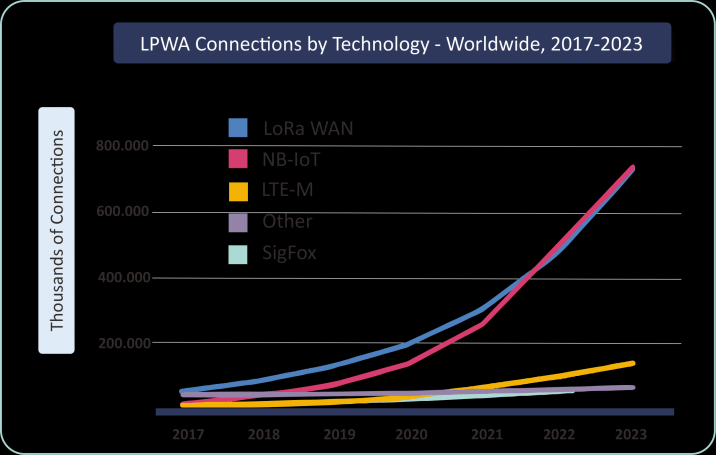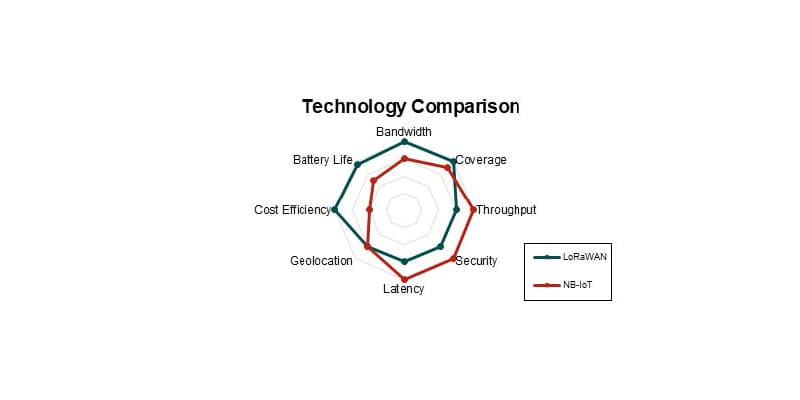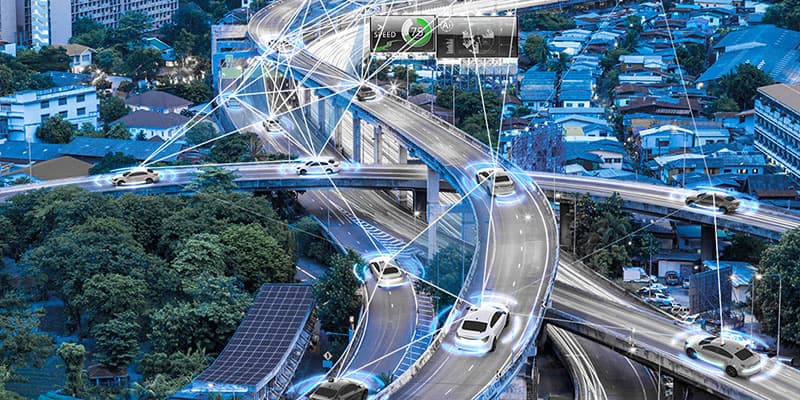LoRaWAN is a low power IoT protocol that comprises the LoRa radio technology, allowing for an open, reliable, and economical network deployment. By contrast, NB-IoT is a licensed LTE radio technology offering low latency and strong security at a steeper price point.
The LoRaWAN and NB-IoT standards are both part of a larger family of technologies known as LPWAN (Low Power Wide Area Networking).
More so than other protocols like Sigfox and NB-Fi, these communication standards are setting the trend for what's to come in IoT.
According to Statista, LoRaWAN and NB-IoT are expected to account for around 85.5% of all LPWAN connections by 2023. This is clearly shown in the graph below:

The overlap between the two is clear, but the question remains:
What makes these two technologies so compelling compared to other protocols? Are LoRaWAN and NB-IoT going after the same market? Or are they destined to niche down into different use cases?
Even though they are in the same category, the way these two technologies are being developed is different.
LoRaWAN is an open protocol offered by the LoRa alliance that uses unlicensed spectrum, allowing almost anyone to set up their own networks at a low cost.
NB-IoT is a licensed protocol from the standards organization 3GPP offered through the licensed RF spectrum, making it available only through established mobile network operators.
So, which one is best for your organization? Let's find out.
Table of Contents
LoRaWAN vs NB-IoT: A Quick Overview
Before we jump into the comparison, here's a quick refresher on both protocols:
LoRaWAN
Following the definition from the LoRa alliance, the LoRaWAN specification is a "Low Power, Wide Area (LPWA) networking protocol designed to wirelessly connect battery operated ‘things’ to the internet in regional, national or global networks by targeting key Internet of Things (IoT) requirements such as bi-directional communication, end-to-end security, mobility and localization services."
This specification comprises the LoRa (Long Range) technology which is a spread spectrum modulation technique derived from Chirp Spread Spectrum (CSS).
This technology is under patent from a company known as Semtech which indirectly charges a small fee on each LoRa chipset in sensors and gateways offered as off-the-shelf solutions for IoT enthusiasts and enterprises alike.
NB-IoT
3GPP does not provide an official definition for the NB-IoT (Narrowband Internet of Things) protocol, also known as LTE CAT NB1. Referring back to one of their press releases from Feb 2016, NB-IoT is defined as "a new radio added to the LTE platform, optimized for the low [bandwidth] end of the market."
NB-IoT was made specifically with low-power stationary sensors in mind. For each device deployed in a network, this protocol offers wide coverage areas with deep indoor penetration.
NB-IoT was made specifically with low-power stationary sensors in mind. The protocol offers wide coverage areas with deep indoor penetration.
Unlike LoRaWAN, this is a licensed protocol that is likely to cost more in the long-term but provide a better overall experience for the end users.
One thing to note is that NB-IoT devices are rapidly moving towards Embedded SIM (eSIM) usage. According to a study by McKinsey & Company, eSIMs would "enable IoT product manufacturers to build devices with 'blank' sims that could be activated in destination countries for a more streamlined equipment connectivity."
To learn more about eSIMs and the future of cellular IoT, check out this presentation from Particle's Sr. Director of Product, William Hart.
LoRaWAN vs NB-IoT: Technology Comparison
ABI Research did a fantastic job at comparing the two technologies. In the table below, you have a complete rundown of technology parameters for both LoRaWAN and NB-IoT:
| Technology Parameters | LoRaWAN | NB-IoT |
|---|---|---|
| Bandwidth | 125 kHz | 180 kHz |
| Coverage | 165 dB | 164 dB |
| Battery Life | 15+ years | 10+ years |
| Peak Current | 32 mA | 120 mA |
| Sleep Current | 1 µA | 5 µA |
| Throughput | 50 Kbps | 60 Kbps |
| Latency | Device Class Dependent | <10 s |
| Security | AES 128 bit | 3GPP (128 to 256 bit) |
| Geolocation | Yes (TDOA) | Yes (In 3GPP Rel 14) |
| Cost Efficiency | High | Medium |
There are a few takeaways to highlight here:
- LoRaWAN consumes less power compared to NB-IoT, making it a more viable solution for projects that require higher refresh rates.
- Since it consumes less power, LoRaWAN also provides a longer battery life compared to NB-IoT (15+ years compared to 10+ years).
- When it comes to bandwidth and coverage, things start to overlap.
- Peak data throughput for NB-IoT is 60 Kbps, a touch higher than LoRaWAN.
- NB-IoT is a more secure solution due to 256-bit 3GPP encryption (compared to AES 128-bit for LoRaWAN).
- Latency on NB-IoT is usually lower than LoRaWAN. As shown on the table, latency on LoRaWAN depends on the type of device used and its classification.
- Both standards support geolocation to the same degree.

The biggest difference between the two is their cost efficiency. LoRaWAN solutions can achieve lower operating costs compared to NB-IoT both because of the use of unlicensed spectrum and because of their lower power consumption (which, in turn, extends battery lifetime and reduces servicing costs).
At 32 mA peak current—one fourth of NB-IoT’s consumption—LoRaWAN devices last longer, especially in applications with high refresh rates.
At 32 mA peak current—one fourth of NB-IoT’s consumption—LoRaWAN devices last longer, especially in applications with high refresh rates.
LoRaWAN’s self-deployment capabilities and the maturity of its chipset, gateway, and cloud service ecosystem makes it a perfect fit for organizations requiring full ownership of their infrastructure, be it in an enterprise campus, smart building, or agricultural crop.
In contrast, NB-IoT is better suited for commercial and consumer IoT applications requiring connectivity at a regional, or even global scale.
LoRaWAN vs NB-IoT: Use Case Comparison

While there is some space for complementary use, it's unlikely that all organizations will choose to go with both LoRaWAN and NB-IoT mainly due to budgetary restraints.
These protocols offer value when applied to specific use cases for existing or new business ventures. Let's look at 3 core variables in more detail and why they matter for each use case:
Power Consumption
| LoRaWAN | NB-IoT | |
|---|---|---|
| TX Current | 24-44 mA | 74-220 mA |
| RX Current | 12 mA | 46 mA |
| Idle Current | 1.4 mA | 6 mA |
| Sleep Current | 0.1 µA | 3 µA |
As shown in the table above (Source: AMIHO Technology), LoRaWAN consumes considerably less power compared to NB-IoT.
It's worth noting that while this increases battery life for the former, both protocols offer a much longer lifespan compared to competitors.
The real question here isn't how long the devices' battery will last during a lab test; it's more about how high the refresh rate will be in a real-world scenario.
The real question isn't how long the devices' battery will last during a lab test. It's more about how high the refresh rate will be in a real-world scenario.
Since deep sleep current for both protocols is virtually zero, the real difference will be noticed when the devices reach peak currents for long periods of time.
This means that LoRa-powered devices are a perfect fit for smart home and smart building applications, as well as the utilities sector where long battery life is key.
LoRaWAN's battery efficiency is also an ideal solution for smoke detectors, smart locks, doors, indoor lights, and metering systems of utility companies.
Mobility

Because LoRaWAN devices register with the network server (not with the gateway), it is possible for a device to move between gateways.
LoRaWAN mobility is officially supported in the class A version (check out this short video to learn more about LoRaWAN classes), but LoRa devices that move between gateways still have a high risk of walking into dead spots.
On the other hand, narrowband IoT was not designed to be mobile. The handshake between an NB-IoT device and the cell-tower is only done once, and even though you could force it to re-scan and register to a new network, this would require more power, in which case you’d be better off using NB-IoT’s sibling—LTE-M.
Narrowband IoT was not designed to be mobile. The handshake between an NB-IoT device and the cell-tower is only done once.
Although it was not built with mobility in mind, the fact that most chipsets include both LTE-M and NB-IoT radios has driven several IoT device manufacturers to introduce NB-IoT-powered GPS trackers and wearables to the market.
If you’re still not convinced with employing NB-IoT for mobility, and are tempted by the available off-the-shelf devices, or falling data plan prices, then we recommend:
- (a) inquiring whether your target users are likely to move around a small area that can be covered through a single base station (<10 km range);
- (b) testing whether the potential energy peaks of continuous network scans/joins will ultimately make NB-IoT comparable to LTE-M.
But why is mobility such a big deal in IoT? What's the use case? Think about logistics... Tracking mobile enterprise assets like vehicles, parcels, and high-value objects is a big market opportunity, one that many companies are trying to fill in.
With experts forecasting another dip in new-vehicle sales, automakers must begin exploring new revenue streams
— Wilko S. Wolters 🇩🇪🇪🇺 (@WSWMUC) January 30, 2020
3 trends could fuel success in 2020 🚘
1️⃣ Subscription model booms
2️⃣ IoT adoption expands
3️⃣ Push for sustainability#mobility https://t.co/mNWwF9R4j4 pic.twitter.com/U0xrkUUJJI
At the moment, it's quite hard to track every asset in real-time, unless all of them are placed under one (small) roof.
With innovations in mobility for IoT chips, businesses could reliably track their assets without having to worry about complex infrastructure.
Cost
| LoRaWAN | NB-IoT | |
|---|---|---|
| Chip | $1 to $2 | $5 to $10 |
| Device | $4 to $6 | $6 to $12 |
| License | Free | Built Into Chip |
| Frequency | License-Free (Sub-GHz) | Licensed (>1 GHz) |
Overall, LoRaWAN is considerably cheaper than NB-IoT. Not only are upfront costs lower thanks to higher market adoption and falling chip prices, but its open standard means bare minimum licensing fees.
By contrast, NB-IoT can be more expensive, especially if you factor in the connectivity costs from cellular providers.
Cost is important across all use cases, but especially so in fields like agriculture where falling commodity prices have made it difficult for farmers to afford IoT innovations.
That's why privately owned LoRaWAN networks are the primary choice for smart agriculture against NB-IoT powered solutions.
There are tons of metrics to compare when it comes to these two heavyweights of the IoT industry, but the three highlighted above are defining for most use cases.
LoRaWAN vs NB-IoT: Which One Is Right For You?
Both LoRaWAN and NB-IoT are crucial to push the IoT industry forward, but which of these is right for your business?
In this short conclusion, we've prepared a simple table to recap some of the use cases and the technologies that are more appropriate for each of them:
| Use Case | Technology |
|---|---|
| Utilities & Smart Meters | Both |
| Smart Home & Building Automation | LoRaWAN |
| Logistics & Asset Tracking | Both |
| Smart Agriculture | LoRaWAN |
| Industrial & Manufacturing | Both |
| Street Lighting & Smart Parking | NB-IoT* |
| Water & Electricity Systems | NB-IoT* |
| Smart Cabinets & Shelves (Retail) | NB-IoT* |
| Wearables & Pet Tracking | Both |
| Warehouse Monitoring | LoRaWAN |
*Unless a region-wide LoRaWAN operator is available, in which case both technologies are comparable.
These are just a few of the many LPWAN technology use cases that are bound to develop in the next 3-4 years.
As interest in the field grows, so will innovation. Which of these technologies will you choose and why? Let us know in the comments down below.


